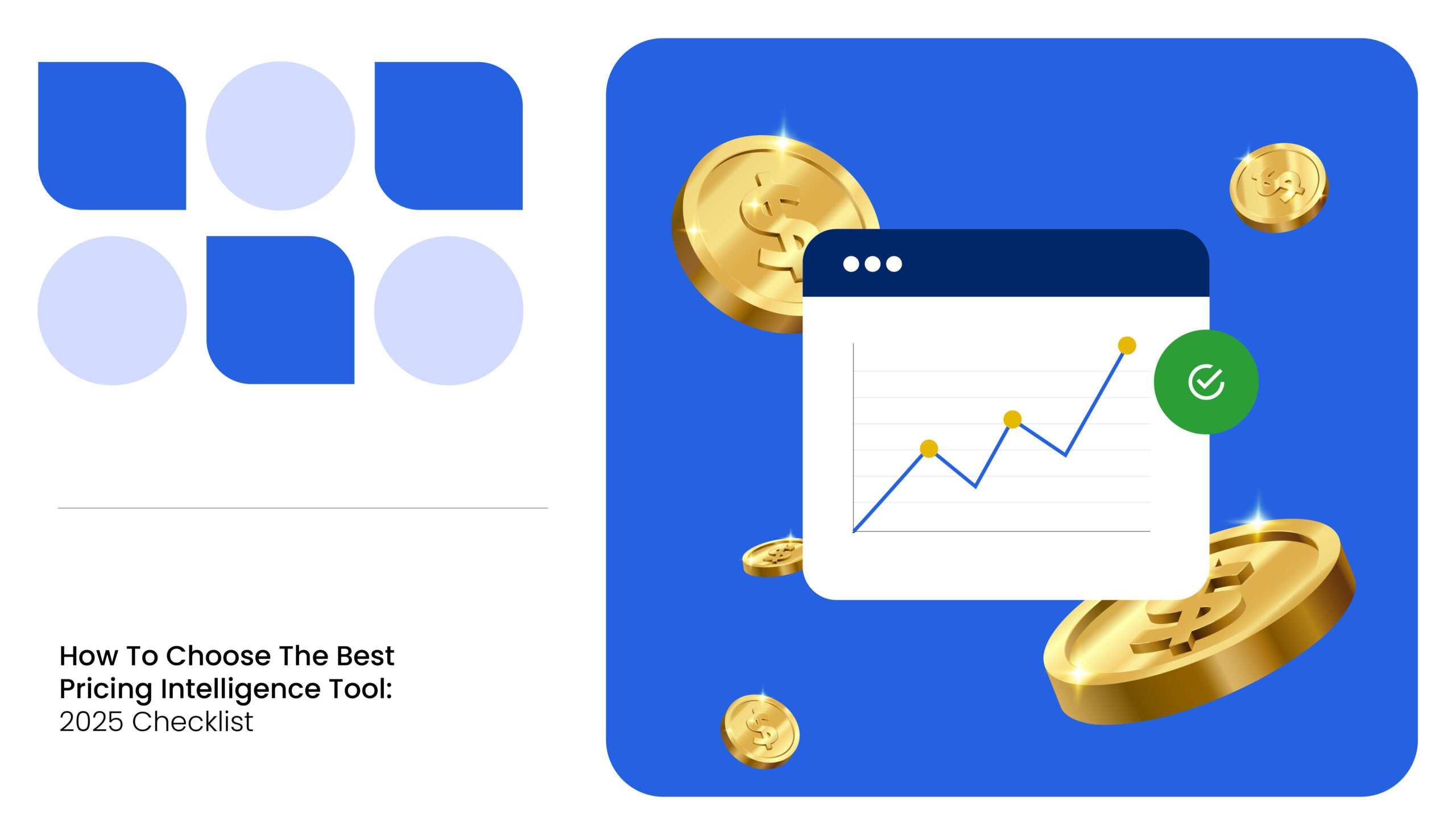According to eMarketer’s February 2024 forecast, the digital grocery market in the US is projected to reach $253.89 billion by 2025, with Walmart, Amazon, and Kroger leading online grocery sales.
As more shoppers buy fresh produce, beverages, and packaged foods online, grocery brands face a tougher challenge: keeping up with fast-changing prices, platform-specific discounts, and hyper-local promotions.
Traditional tracking methods can’t keep pace with this dynamic environment. To stay competitive, brands need advanced price monitoring tools that deliver real-time visibility across retailers.
A robust grocery price tracker for brands, such as MetricsCart, enables them to identify regional price gaps, monitor competitors, optimize pricing, analyze trends, and drive sales.
Challenges of Tracking Grocery Prices Online
Dynamic Pricing Across Retailers
Unlike brick-and-mortar stores, where prices may stay fixed for weeks, e-commerce platforms adjust prices constantly, sometimes multiple times within the same day. For instance, Amazon makes 2.5 million price changes daily across its vast catalog.
In the grocery category, these fluctuations are even more pronounced because pricing is influenced by inventory levels, shopper demand, competitor promotions, and even the time of day. A carton of eggs or a box of cereal might cost one amount in the morning, and a slightly higher or lower price just hours later.
This is evident during high-demand periods such as holidays, seasonal promotions, or when a product starts trending on social media. Prices can also spike when supply is low, only to drop sharply when competitors introduce discounts or coupons.
These constant shifts mean a price you checked yesterday or this morning may already be outdated. In addition, without an e-commerce price tracking tool, it’s easy to miss when a competitor undercuts your price.
Frequent changes can also lead to inconsistencies across channels, negatively impacting both sales performance and brand trust.
READ MORE | Struggling to Implement Dynamic Pricing? Check out Dynamic Pricing in E-Commerce: Strategies and Insights
Platform-Specific Discounts
Each retailer runs its own deals and coupons, often for very short durations. Walmart’s “Rollback” discounts, Amazon’s flash sales or coupon offers, and Target Circle coupons all create temporary price changes.
In addition, retailers often launch overlapping promotions to compete. In 2025, Amazon’s four-day Prime Day sale coincided with Walmart’s six-day Deals Week, causing price fluctuations across grocery staples.
For brands, missing even a short-term price cut can lead to lost visibility, buy box loss, misaligned promotions, and poor sales and market share during the promo window, especially in fast-moving grocery categories like snacks, dairy, and beverages.
Category Fragmentation
Unlike electronics or fashion, the grocery category is complex due to its extensive catalog and constant product turnover. Retailers like Amazon, Walmart, Kroger, and Target host thousands of grocery SKUs, spanning staples like rice and milk to niche categories such as plant-based snacks, organic produce, and functional beverages.
Each of these comes with its own pricing, promotion cycles, and stock dynamics. Moreover, product fragmentation makes it harder for brands to track consistent pricing trends across retailers:
- Unique product identifiers: A single SKU might carry different IDs across Walmart, Amazon, and Target, making it difficult to line up comparisons.
- Inconsistent naming conventions: The same cereal box might appear as “Cheerios 500g” on one retailer and “General Mills Cheerios Family Pack, 17.6oz” on another.
- Packaging and size variations: Multi-packs, family packs, or limited-edition flavors often overlap with core SKUs, which can blur visibility.
- Duplicate listings: Multiple sellers may list the same grocery item with alternate titles, images, or keyword-optimized descriptions. This clutters search results and inflates catalog size, making manual tracking nearly impossible.
For brands, this fragmentation means that without an online grocery price tracker, you risk misinterpreting price movements due to mismatched SKUs, overlooking competing formats (such as single-serve vs. multi-pack beverages), and losing pricing control in key categories.
Unauthorized Sellers and Price Wars
Most grocery shoppers are highly sensitive to pricing. Even a small price drop from an unauthorized seller can divert purchases away from official channels, impacting both revenue and market share.
Moreover, many grocery items are perishable, require careful packaging, and carry strict quality expectations. When unauthorized sellers fail to meet these standards, customers quickly lose trust in the brand, even if the official product is high-quality. This can have long-term consequences for brand reputation and repeat purchase behavior.
Grocery categories are challenging to monitor manually due to SKU complexity, such as multiple variants (pack sizes, organic vs. conventional, limited editions, bundle offers), frequent promotions and price fluctuations, and duplicate or slightly altered listings from different sellers.
This leaves brands vulnerable to unauthorized discounting, price wars, and missed opportunities to respond to competitive threats.
What does MetricsCart Grocery Price Tracker for Brands Offer?
Given the numerous challenges grocery brands face online, let’s look into how MetricsCart, an online grocery price tracker, can help them effectively:
Real-Time SKU-Level Pricing
![]()
As discussed earlier in online grocery, a cereal box or a soft drink pack can change price multiple times a day. MetricsCart’s grocery price tracker for brands automatically tracks each SKU’s price across retailers with very high frequency. Its platform refreshes data as frequently as every 10 seconds, across Amazon, Walmart, and Target.
For example, if Walmart launches an unexpected “Rollback” on a leading peanut butter brand at 10 AM, MetricsCart flags it instantly. Brand managers can immediately decide whether to match the drop, hold steady to protect margins, or launch a targeted promo elsewhere. This speed and visibility prevent lost market share.
Promo & Coupon Monitoring
Beyond the base price, MetricsCart catches time-limited discount offers. It alerts you to flash sales, limited-time markdowns, and site-specific coupons as soon as they appear.
MetricsCart grocery price comparison tracker surfaces when competitors run sudden discounts (whether Amazon Lightning Deals, Walmart Rollbacks, or Target Circle offers), so brands can respond promptly.
If Target launches a Circle discount on your competitor’s coffee while Amazon stacks coupons on the same SKU, MetricsCart flags both events in real time. You can quickly reallocate ad spend, adjust pricing, or shift inventory to stay competitive.
Beyond just tracking promos, MetricsCart gives brands a deeper competitive edge by analyzing sponsored and featured products to see how competitors are gaining visibility during promotional windows.
Category-Wide Benchmarking
The grocery price tracker for brands aggregates pricing data at the category level to show distribution and trends. For example, MetricsCart can display how many SKUs in “Packaged Foods” fall into various price bands, revealing high-competition zones versus gaps.
If most snack SKUs cluster around the $6–$7 price range, but very few exist in the $9–$10 band, a brand might consider positioning a new premium SKU there to capture unaddressed demand.
Brands can also see median and average prices by subcategory, spotting whether they’re positioned as premium or value players. This allows brands to identify category-level pricing clusters and benchmark their products against competitors.
This helps identify opportunities (e.g., under-priced premium SKUs) or threats (e.g., category overstock driving prices down), empowering brands to decide whether to defend their turf, move upmarket, or launch new products into underserved price zones.
Brand-Level Insights
While category-wide data reveals the broader picture, brand-level insights enable teams to drill down into their own performance and safeguard brand value across retailers. MetricsCart e-commerce price tracking tool consolidates all your brand’s data into clear dashboards that compare your position against both competitors and the overall category.
With MetricsCart, brands can:
- Benchmark average prices vs. category norms: See if your snack bars, dairy products, or beverages are positioned as premium, mid-tier, or value relative to competitors.
- Track market share by segment or retailer: Understand how your share shifts across Amazon, Walmart, or Target in response to price changes or promotions.
- Enforce pricing policies: MetricsCart flags violations of Minimum Advertised Price (MAP) and alerts you when unauthorized discounts are detected.
By combining enforcement with performance tracking, MetricsCart helps brands protect their perceived value, prevent price erosion, and maintain stronger control over how their products are presented in the market.
AI-Powered Product Matching
Grocery categories are highly fragmented- think of 500ml vs 1L milk packs, or family-sized chip bags vs snack packs. Comparing competitor SKUs manually often leads to mismatches.
MetricsCart uses AI-driven product matching to connect both exact and similar grocery items across multiple retailers, ensuring reliable comparisons.
For instance, if you sell a 6-pack of soda cans, the tracker automatically finds equivalent multipacks (like 8-packs or 12-packs) across Amazon, Walmart, or Target. This gives you accurate, apples-to-apples pricing intelligence without the messy manual work.
Multi-Retailer Coverage
MetricsCart lets you monitor all primary grocery channels in one place. Its coverage includes Amazon, Walmart, and Target, among others. Instead of logging into separate retailer portals or spreadsheets, managers get a unified dashboard.
This multi-channel perspective is crucial: price wars often unfold differently on each site. Using the grocery price tracker for brands, you can quickly spot if your tomato sauce is being undercut on Amazon but overpriced on Walmart, allowing faster corrections.
With MetricsCart, your team can conduct SKU-level monitoring across all retailers at once and instantly see how prices move on every front. You can detect price wars or misalignments across platforms early and make strategic decisions.

How Grocery Brands Can Use the E-commerce Price Tracking Tool?
- Set Real-Time Alerts & React Quickly: You can configure alerts for specific price moves or undercutting. When a competitor drops price or launches a promo, MetricsCart notifies you immediately.
- Optimize Your Pricing Strategy: By seeing your SKUs’ position in the category price spectrum, you can adjust list prices or offers to match your strategy.
- Time Promotions & Discounts: Instead of guesswork, brands can time their promotions based on competitor patterns.
- Ensure MAP Compliance and Distributor Accountability: With alerts on unauthorized price hikes or drops, brand teams can enforce Minimum Advertised Price policies. If the tool flags a reseller dumping inventory, you can take action or supply more inventory strategically.
Conclusion
Tracking grocery prices online requires diligence and the right tools. The challenges are real – dynamic repricing, fragmented categories, and rapid promotions – and they only intensify as e-commerce grows.
MetricsCart’s Grocery Price Tracker addresses these pain points by delivering automated, real-time pricing and promotion data across Amazon, Walmart, Target, and more.
Armed with this intelligence, CPG brands can protect margins, enforce pricing policies, and stay one step ahead of competitors.
Take Control of Your Pricing Strategy.
FAQs
Groceries have thousands of SKUs, rapid price changes, multiple sellers, and region-specific promotions. Even the same product may appear under different IDs or packaging variations, making consistent tracking difficult.
Flash sales, coupons, and loyalty discounts (e.g., Prime Day, Walmart Rollbacks, Target Circle) create short-term spikes or drops that distort competitive visibility. Without monitoring tools, brands can miss these shifts and lose market share.
Unauthorized sellers may undercut official prices or sell low-quality items. This can hurt brand reputation, confuse buyers, and lead to price wars that reduce margins.
MetricsCart refreshes data as frequently as every 10 seconds, instantly capturing flash sales, coupon activations, and loyalty-based discounts across Amazon, Walmart, and Target.
It’s designed for brand managers, category managers, pricing analysts, and e-commerce teams who need real-time visibility and control over online grocery pricing across platforms.




